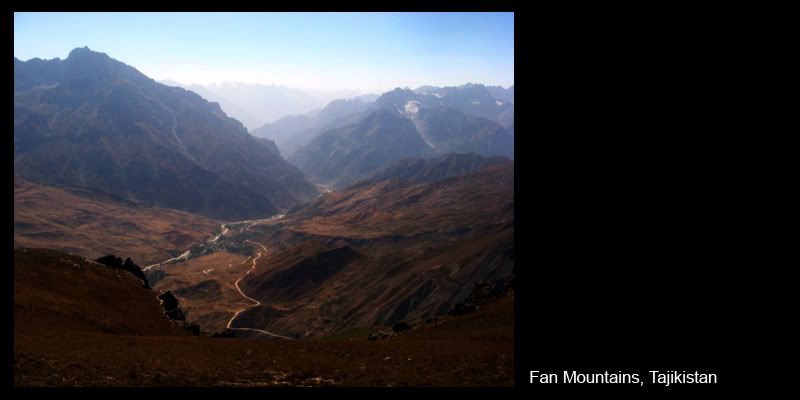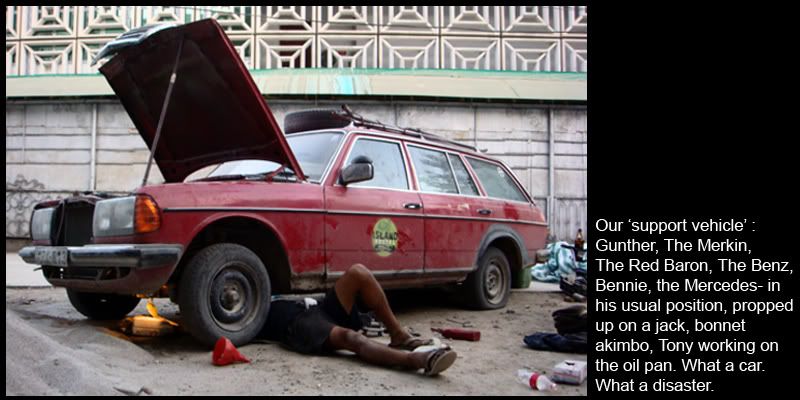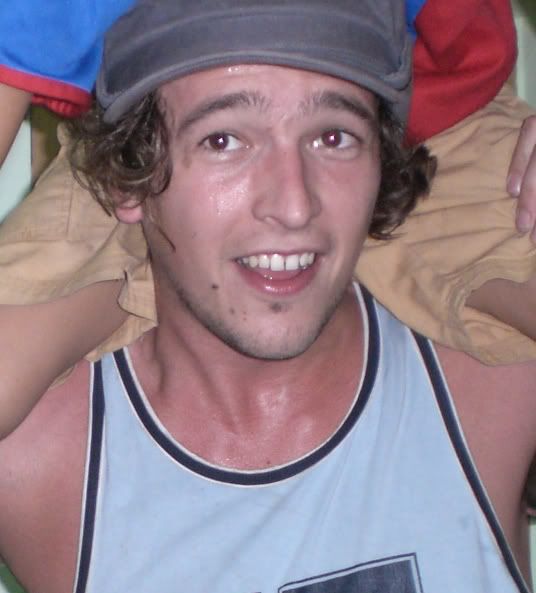Fan Mountains, Tajikistan
14th September, 2007
by Dan Murdoch

WE WAITED for ten minutes then turned back to see what had happened to the others.
Gunther was pulled over to the side of the road. OJ and Carlos were emptying out the boot.
“We’re ditching Gunther. The oil pans gone again.”
My first thought was agreement. The oil pan has now cracked three times. I did the first one in Georgia a month ago. We used resin to fill the crack, but it took a day, and a seven-hour tow along some appalling roads.
When we got to Yerevan in Armenia I drove around the city’s mechanics trying to find someone to weld a protective plate under the Merkin– it took another day and another $100.
But in Turkmenistan it went again – this time sheered completely off by the plates that were supposed to be protecting it. Ooh the bitter irony.
That took a day to fix, but ended up costing us five days and hundreds of dollars when we over stayed our visas.
It always happens on the same sort of road- the boulder strewn , cratered paths through sandy desert or rocky mountains. We should probably drive slower on them.
But it isn’t just the oil pan that has given us trouble.
The windshield smashed in Romania, although that was entirely our fault, and we had to remove the remains of the LPG tank that Gabor, our Budapest mechanic, forgot to take out. More time, more money.
The hydraulic suspension has been a mare. Often refusing to go up, which limits the Mirkin to about 10mph. On occasions we have to jack up the back and rev the engine for a while to get it to lift. And the Red Barron, which handles like a boat, has had more punctures than all the Trabbis put together.
But Old Gunther cost us just $3,000 and is hopelessly overloaded. We filled it with enough spare parts to start our own junkyard. Odds and ends that I will never understand. Huge arced chunks of metal riveted to rusty plates on springs. Small, loose bolts in plastic dishes with light bulbs and bent washers. Greasy rods wrapped in plastic bags, tangled with dusty sheets and frayed rope.
But it’s Tony’s domain and we mostly leave it to him to organise. He uses a thoroughly personalised filing system undecipherable to even the most sideways thinking cryptologist.
Carrying a junkyard across the world in a 1979 Mercedes station wagon is almost as stupid as trying to get three Trabbis across. Perhaps this should be Merkin Mission.
 Lovey was a bit more realistic about the prospect of ditching it. The Merc is meant to be our workhorse. If the Trabbis themselves were carrying all the extra weight, they would probably be breaking down regularly too.
Lovey was a bit more realistic about the prospect of ditching it. The Merc is meant to be our workhorse. If the Trabbis themselves were carrying all the extra weight, they would probably be breaking down regularly too. We discussed the consequences:
More weight for the Trabbis, so probably more breakdowns.
Less spare parts, so a higher chance that we don’t reach Cambodia, or lose a car on the way.
Where do we leave it? On the side of the road? How will Tajik customs feel when we show up with one less car than we arrived in?
And the car is registered to Zsofi in Hungary, she has to present some papers to the authorities in Budapest to show what’s happened to the car.
The arguments for ditching it:
It’s a fucking pain the arse.
Fewer breakdowns, we’d make better time. Disputed.
It’s a gaping hole that we’re pouring cash into.
Less cars at the borders means less money to cross.
Nobody likes driving it.
Factored into our thinking was the Pamir Highway, the next great test for out motorcade.
The Pamir Mountains. As the Indian subcontinent pushes at the belly of Asia, the ripple and shock forces up the land right into the heart of Asia. The tectonic plates crack, split and push skyward, creating epic ranges that grow every year.
The world’s highest ranges collide here, the Tian Shan to the northeast, the Hindu Kush to the west, the Himalayas to the south. This is the roof of the world according to locals, and it feels like it.
The highway itself is a feat of Soviet engineering, built to link this remote outpost of their empire. It scales passes 5,000m high, rising and dipping through remote deserts and snowy plateaus in the sky. Icy mountain lakes leak clear clean water down the hillsides.
The valley kingdoms there are so isolated, so remote, that they have entirely different languages.
Why settle here in perfect isolation? Inhabited islands in the vast wilderness.
The world’s highest highway is not in terrible condition. But parts are incredibly steep, perhaps too steep for our overloaded Trabbis. The East Germans never imagined people would be taking the cars high above Europe’s tallest peaks, and we cant be sure how the engine will respond to the atmosphere’s thinning oxygen supply. Tony thinks he can adjust the carburettors to let more air in, but no one really knows.
Breaking down in the Pamirs would not be good. And without the Mercedes we would have even less of a chance of repairs.
In the end we compromised- we would keep the Mercedes but ditch a load of weight to try and reduce the amount of breakdowns.
There’s no doubt we didn’t need all the spares – something we blame Gabor for. I just know that we’ll need some of the parts that we have thrown away– probably just when we get to the other side of this mountain.
Ends
mrdanmurdoch@gmail.com


No comments:
Post a Comment